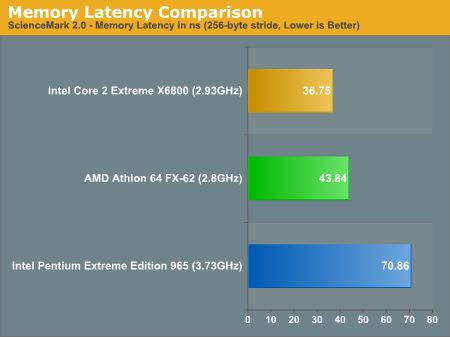Intel's Core 2 Extreme & Core 2 Duo: The Empire Strikes Back
by Anand Lal Shimpi on July 14, 2006 12:00 AM EST- Posted in
- CPUs
Memory Latency: No Integrated Memory Controller Necessary
One thing we pointed out in our earlier preview coverage of Intel's Core 2 Extreme is that the new processors have extremely low latency memory access, despite relying on the same memory controller as the previous generation of Intel CPUs.
Without an on-die memory controller Intel's Core 2 processor must use the memory controller in its chipset, which currently means the 128-bit DDR2 memory controller in either Intel's 965 or 975X chipset. The confusing thing is that although the Core 2 processors use the same memory controller as the old NetBurst processors, memory latency has been improved tremendously:

Intel's Core 2 processors now offer even quicker memory access than AMD's Athlon 64 X2, without resorting to an on-die memory controller. While Intel will eventually add one, the fact of the matter is that it's simply not necessary for competitive memory performance today thanks to Intel's revamped architecture. Update:As many astute readers have pointed out, Core 2's prefetchers are able to work their magic with ScienceMark 2.0, which results in the significant memory latency advantage over AMD's Athlon 64 FX-62. This advantage will not always exist; where it doesn't, AMD will continue to have lower latency memory access and where it does, Intel can gain performance advantages similar to what ScienceMark 2.0 shows.
| CPU | Everest |
CPU-Z 1.35 (8192KB, 128-byte stride) | CPU-Z 1.35 (8192KB, 64-byte stride) |
| AMD Athlon 64 FX-62 (2.8GHz) | 45.9 ns | 43.2 ns | 19.3 ns |
| Intel Core 2 Extreme X6800 (2.93GHz) | 59.8 ns | 52.8 ns | 10.9 ns |
Because of the Core 2's intelligent prefetchers doing too good of a job with ScienceMark memory latency test, we wanted to also showcase situations where Core 2 would feature slower memory accesses than the AMD platform with its integrated memory controller. Everest's results are more in line with what we'd expect to see, with the FX-62 offering over 23% faster memory accesses than the X6800. CPU-Z's latency tool also reported somewhat similar findings, with an 18% performance advantage due to AMD's integrated memory controller. CPU-Z also provided us with numbers that showcase how well Core 2 can perform if its prefetchers are able to "guess" correctly; at lower strides the Core 2 Extreme manages faster memory access than the FX-62. The 128-byte stride numbers are indicative of what will happen if the pre-fetchers are not able to get the Core 2 the data it needs, when it needs it, while the 64-byte numbers show you what can happen when things go well.










202 Comments
View All Comments
invise - Friday, July 14, 2006 - link
According to page 3 "The Test", you used an Intel D975xBX motherboard (Intel 975X chipset) for the tests in the article. Yet in the picture of the Tuniq Tower on page 18 "Overclocking", there is clearly an Asus board with a gold/copper chipset heatsink, blue PCI-Express 16x slot, and alternating yellow and black DIMM slots. Which board is this? I suspect a P5WD2 or P5N32-SLI, just from looking at pictures online, but from what I can find neither of those has a gold/copper heatsink on the Northbridge.I'm curious because you got the board's FSB stable at 445 MHz, which is critical when working with a CPU with a low, locked multiplier. If any other users recognize the board please ID it.
spug1 - Friday, July 14, 2006 - link
I noticed that too Invise. Can we have some clarification as to whether you used the intel board, or the asus p5w-dh for the testing of conroe?!
cheerz, :)
JarredWalton - Friday, July 14, 2006 - link
Overclocking was done with the ASUS board. The benchmarks scores were tested on the Intel board as reported on page 3.Suraj - Friday, October 20, 2006 - link
What other parts did u change when overclocking? I'm very eager to know what exact parts u used when overclocking the e6600.Kiste - Friday, July 14, 2006 - link
Great review, as always. I have to admit though that I was hoping for a bit more with regard to i965 based mainboards.Gary Key - Friday, July 14, 2006 - link
We have a few P965 boards in house currently, however all of them are undergoing almost daily bios changes. They should be very solid from a performance viewpoint within 30 days but at this time they are still immature and any performance results shown with them are not final.
Wesley Fink - Friday, July 14, 2006 - link
You will see Conroe motherboard reviews the first of the week, and yes, there are 965 boards in the reviews.DrMrLordX - Friday, July 14, 2006 - link
Could you guys please do a mini-review of this chip? In particular, could you overclock it using a Tuniq Tower 120 or something and give us some idea of how high it will go? I've been wanting to know more about that proc since AM2 launched, but AMD has been doing a lousy job of getting them into retail channels.redpriest_ - Friday, July 14, 2006 - link
Very detailed, I loved it. But quick question: Your screenshots with cpuid have the stepping as a B1 stepping 5 Conroe - I bought a retail Conroe X6800, and it was a stepping 6 revB2 - and it "only" clocks to 3.466 ghz stably. 3.733 is unstable and 4 ghz is a no boot into Windows; so my question is - is that the stepping you used or was it just a screenshot from an older comparison?Wesley Fink - Friday, July 14, 2006 - link
Our review samples are all Stepping 5. We also have an earlier Stepping 4 unlocked E6700 that overclocks very well. We understood stepping 5 was the Retail stepping. We will clarify this with Intel later today.